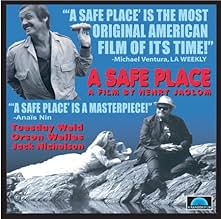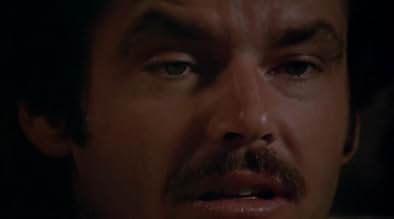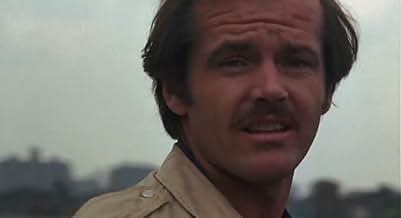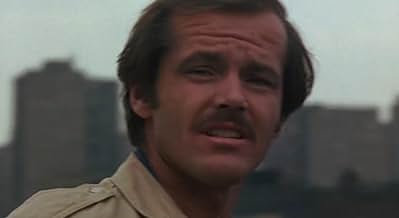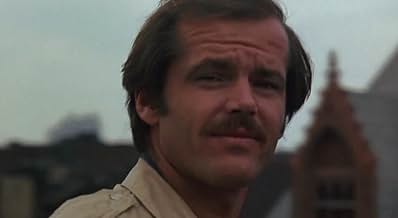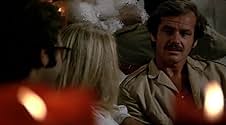AVALIAÇÃO DA IMDb
4,9/10
1,4 mil
SUA AVALIAÇÃO
Uma jovem estranha vive em um mundo de fantasia onde ela nunca poderá crescer.Uma jovem estranha vive em um mundo de fantasia onde ela nunca poderá crescer.Uma jovem estranha vive em um mundo de fantasia onde ela nunca poderá crescer.
- Prêmios
- 1 indicação no total
Phil Proctor
- Fred
- (as Philip Proctor)
Rachel Harlow
- Noah's Friend
- (as Richard Finnochio)
Wendy Girard
- Girl at the Party
- (não creditado)
Avaliações em destaque
One might be tempted to call Henry Jaglom's directing debut "A Safe Place", which he also wrote (based on material he originally presented on stage in New York), self-indulgent; however, the indulgence here really belongs to the editor, Pieter Bergema. This is a movie 'made' in its editing stages, and either Bergema had too much film to work with or not enough (this might explain the endless close-ups of crying or howling faces, several of them repeated). Tuesday Weld plays a commune-living hippie chick in New York City, on a tightrope between being a woman and wanting to remain a child, who begins a relationship with a drop-out from high society before she has resolved her feelings for former boyfriend Jack Nicholson, who apparently left her for another woman. Jaglom encourages his cast to wing it, and so we're left with lots of rambling, pseudo-introspective monologues about illusion and reality. It's wise not to try and dissect "A Safe Place"--that would be like analyzing a snowflake. There's just not enough real substance here--nor enough real acting--to spark a debate on the film. Orson Welles as a magician (or perhaps Weld's guardian angel) looks like a cross between Jackie Gleason and Oliver Hardy; he has fun doing magic tricks in Central Park, but is mostly used as a shoulder for Weld to lean on. Weld herself is a lovely presence (although this little-girl-lost number was just about played out), and cinematographer Dick Kratina gets some gorgeous shots of her all around the city, but the only genuine acting in the film comes from newcomer Gwen Welles as another hippie who is mesmerized by the non-meaning of her dreams. ** from ****
A strange young woman (Tuesday Weld) lives in a fantasy world where she can never grow up.
Henry Jaglom's directorial debut was a "critical and box-office disaster". Time magazine called the film "pretentious and confusing", a film that "suggests that the rumors of his expertise were greatly exaggerated, or at least that it does not extend to directing." Apparently, for the critics, not even the presence of the incredible Orson Welles or Jack Nicholson could save this one.
Author Anais Nin was perhaps the most kind. She called the film "an impressionistic film, an X ray of our psychic life, which gives an insight instantly into the secret self." She called it a "masterpiece", and praised it for its dreamlike quality that could only be captured on film.
Henry Jaglom's directorial debut was a "critical and box-office disaster". Time magazine called the film "pretentious and confusing", a film that "suggests that the rumors of his expertise were greatly exaggerated, or at least that it does not extend to directing." Apparently, for the critics, not even the presence of the incredible Orson Welles or Jack Nicholson could save this one.
Author Anais Nin was perhaps the most kind. She called the film "an impressionistic film, an X ray of our psychic life, which gives an insight instantly into the secret self." She called it a "masterpiece", and praised it for its dreamlike quality that could only be captured on film.
The title of my review is no exaggeration. The only saving grace to watching this movie is that it's only about an hour and a half in length, even though it seems at least twice that long to view. The screenplay (assuming there really was a screenplay to begin with, because the dialogue feels totally improvised...not because it sounds "real", but because it's strained and ludicrous) is annoying to the nth degree, unless you like hearing profound voice-over comments such as "I love you from New York to Rome..from Rome to Madrid, etc. etc. etc. over and over and over again. If I was on a deserted island with a DVD player and this was the only DVD I had with me, I'd break it in a hundred pieces with a coconut because, otherwise, I'd end up searching for a shark to eat me as soon as possible. If I had a choice between being water-boarded and being forced to watch this movie repeatedly, I'd have a VERY tough decision to make. But, other than that, the movie was great.
Henry Jaglom has often been accused, justifiably, of self indulgent movie making. "A Safe Place" is no exception, yet here it's an indulgence in experimenting with cinematic form itself. As always with Jaglom, it's a pretty mixed bag. There are scenes with some striking moments, but many which ramble on for much too long.
The question remains does this experiment work ? The answer has to be no. But the attempt itself is not without interest. While much of the film will certainly test your patience, the rewards are there, though not as predominant as to make one want to champion this as a film that should be seen.
The film is centered round Tuesday Weld. Weld has always been something of an enigma. The movie persona of her earlier films established her firmly in the mind of the public as yet another pretty blonde. It took her a long time to shake this off. This need to find herself as an actress to be reckoned with must surely have drawn her to this project, written and directed by a newcomer. Her beauty and talent are in abundance here. This may have led to her next big role, made the following year; "Play It As It Lays". Sadly, despite a great performance, Weld never seemed to be able to prove her worth to the wider public or indeed the studios and moved towards a career in mainstream television movies, in which she still managed to shine.
"A Safe Place" boasts an intriguing cast. Alongside Weld is Orson Welles, a close friend of Jaglom's, obviously having much fun as a magician of sorts as well as a young and as always devilish, Jack Nicholson. Jaglom allows them much room for improvisation. He once related having written a scene for Nicholson and Weld; it somehow wasn't working. His feeling was that knowing them personally, they were both far more interesting people than the scene he had written for them showed. He simply let them improvise their dialog.
"A Safe Place" is the kind of film that sounds more interesting than is actually the case. I for one, despite being in favor of much of Jaglom's work and certainly that of Welles, Nicholson and Weld, am reticent in recommending it. For those with special interest in these people or the times, (New York, 1971), there will be points of interest but I must admit to being ultimately somewhat let down to what I sensed could have been far more than what I found.
The question remains does this experiment work ? The answer has to be no. But the attempt itself is not without interest. While much of the film will certainly test your patience, the rewards are there, though not as predominant as to make one want to champion this as a film that should be seen.
The film is centered round Tuesday Weld. Weld has always been something of an enigma. The movie persona of her earlier films established her firmly in the mind of the public as yet another pretty blonde. It took her a long time to shake this off. This need to find herself as an actress to be reckoned with must surely have drawn her to this project, written and directed by a newcomer. Her beauty and talent are in abundance here. This may have led to her next big role, made the following year; "Play It As It Lays". Sadly, despite a great performance, Weld never seemed to be able to prove her worth to the wider public or indeed the studios and moved towards a career in mainstream television movies, in which she still managed to shine.
"A Safe Place" boasts an intriguing cast. Alongside Weld is Orson Welles, a close friend of Jaglom's, obviously having much fun as a magician of sorts as well as a young and as always devilish, Jack Nicholson. Jaglom allows them much room for improvisation. He once related having written a scene for Nicholson and Weld; it somehow wasn't working. His feeling was that knowing them personally, they were both far more interesting people than the scene he had written for them showed. He simply let them improvise their dialog.
"A Safe Place" is the kind of film that sounds more interesting than is actually the case. I for one, despite being in favor of much of Jaglom's work and certainly that of Welles, Nicholson and Weld, am reticent in recommending it. For those with special interest in these people or the times, (New York, 1971), there will be points of interest but I must admit to being ultimately somewhat let down to what I sensed could have been far more than what I found.
Only in the post-"Easy Rider" early 1970s could a film like this be made by a major Hollywood studio. Totally devoid of anything resembling a plot, "A Safe Place" will probably seem incomprehensible to most. But if you already have an appreciation for the 1950s-1960s works of Fellini, Antonioni or Godard, come on in. You'll feel right at home in this "Safe Place."
Henry Jaglom was the unsung hero amongst the circle of friends that brought us "Head," "Easy Rider," "Five Easy Pieces," and several other lesser-known classics of the era. Jaglom is more responsible for the success of "Easy Rider" than Dennis Hopper, as he took Hopper's three-hour cut--a mishmash of flashbacks, flash-forwards and art- damaged nonsense--and shaped it into the legendary film it is today. His close relationship with Hopper, Jack Nicholson, Bob Rafelson, Bert Schneider, and others gave him a chance to write and direct his own movie for Columbia Pictures.
Jaglom in turn delivered this dream narrative starring Tuesday Weld as a young woman who copes by retreating into isolationism and fantasy. Orson Welles pops up here and there as a magician who represents a physical emodiment of her retreat from the world. Or does he only exist in her head?
It's best not to ask questions like that. Free your mind, sit back, and take in the feeling and mood. Where Hopper failed with his cut of "Easy Rider" and "The Last Movie", Jaglom effortlessly succeeds with such lofty and artsy ambitions. "A Safe Place" coasts by like a gentle dream in an afternoon nap--full of beautiful, detached imagery, illogical but comforting.
"A Safe Place" is a beautiful relic of a brief time in American cinema. Even Jaglom-- always on the fringe of mainstream cinema--would never make anything like this again, as he later developed the documentary/verite style which has become his trademark.
Henry Jaglom was the unsung hero amongst the circle of friends that brought us "Head," "Easy Rider," "Five Easy Pieces," and several other lesser-known classics of the era. Jaglom is more responsible for the success of "Easy Rider" than Dennis Hopper, as he took Hopper's three-hour cut--a mishmash of flashbacks, flash-forwards and art- damaged nonsense--and shaped it into the legendary film it is today. His close relationship with Hopper, Jack Nicholson, Bob Rafelson, Bert Schneider, and others gave him a chance to write and direct his own movie for Columbia Pictures.
Jaglom in turn delivered this dream narrative starring Tuesday Weld as a young woman who copes by retreating into isolationism and fantasy. Orson Welles pops up here and there as a magician who represents a physical emodiment of her retreat from the world. Or does he only exist in her head?
It's best not to ask questions like that. Free your mind, sit back, and take in the feeling and mood. Where Hopper failed with his cut of "Easy Rider" and "The Last Movie", Jaglom effortlessly succeeds with such lofty and artsy ambitions. "A Safe Place" coasts by like a gentle dream in an afternoon nap--full of beautiful, detached imagery, illogical but comforting.
"A Safe Place" is a beautiful relic of a brief time in American cinema. Even Jaglom-- always on the fringe of mainstream cinema--would never make anything like this again, as he later developed the documentary/verite style which has become his trademark.
Você sabia?
- CuriosidadesJack Nicholson appeared in this film mainly as a favor to director Henry Jaglom. Nicholson did the film for no pay, his only demand was that he be given a new color television set.
- Erros de gravaçãoThe opening credits read: "Introducing Jack Nicholson." Jack Nicholson had already appeared in 22! feature films before this one.
- Citações
Opening Credits: Introducing Jack Nicholson
- Cenas durante ou pós-créditosThe opening credits read: "Introducing Jack Nicholson." Jack Nicholson had already appeared in 22! feature films before this one.
- ConexõesFeatured in Can She Bake a Cherry Pie? (1983)
Principais escolhas
Faça login para avaliar e ver a lista de recomendações personalizadas
- How long is A Safe Place?Fornecido pela Alexa
Detalhes
- Data de lançamento
- País de origem
- Central de atendimento oficial
- Idioma
- Também conhecido como
- A Safe Place
- Locações de filme
- Empresas de produção
- Consulte mais créditos da empresa na IMDbPro
- Tempo de duração1 hora 34 minutos
- Cor
- Mixagem de som
- Proporção
- 1.85 : 1
Contribua para esta página
Sugerir uma alteração ou adicionar conteúdo ausente

Principal brecha
By what name was Refúgio Seguro (1971) officially released in Canada in English?
Responda

